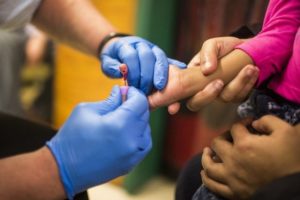
Breeze Harden, 3, has her blood drawn while sitting on the lap of her mother, Darlene Hart, during a lead-testing event Jan. 26. Photo courtesy of the Flint Journal
Lead contamination is shaping up to be a statewide issue for Michigan, as 3.4 percent of its youngest residents tested for lead poisoning last year had elevated levels of the chemical element in their bloodstreams.
Per a report released Monday by Michigan’s state Department of Health and Human Services, almost 5,000 children — age 6 and under — had blood tests that measured above 5 or more micrograms of lead per deciliter. For state health officials, these levels are considered elevated.
According to the report, the results of the study are provisional and “may not match numbers in the final 2015 data report when it is published.”
Compared to the percentage of kids with increased blood lead levels in 2014 (3.5), the data from children tested in 2015 isn’t too far off.
“Overall it’s about where we were last year, but it [blood lead levels] varies county to county and even ZIP code to ZIP code,” said Michigan DHHS spokeswoman Jennifer Eisner.
MLive reports that Lenawee County ranked No. 1, boasting the highest percentage of children with elevated lead levels in their blood; 10 percent out of 1,042 children tested above the threshold. The city of Detroit came in close second at 7.5 percent. Mason followed with 6.5 percent, Kent at 6.2, Jackson with 5.2, and Menominee finishing with 5.1 percent.
“Policymakers should pay attention to these numbers in their districts, because this isn’t a Detroit issue or a Flint issue; this is a statewide issue,” said Tina Reynolds, health policy director for the Michigan Environmental Council.
So how do these other cities’ blood lead levels compare to Flint’s? According to MLive, Flint showed just 2.3 percent of children with at least 5 micrograms of lead per deciliter. However, one ZIP code in particular, 48503, reported 5.7 of its children having increased levels of lead in their blood.
The predominately Black city of Flint suffered a crippling water crisis after city officials began drawing water from the contaminated Flint River. Lead then leached into the city’s water supply, causing a spike in lead poisoning and Legionnaires’ cases. Residents are still feeling the effects of the crisis, relying on bottled water for cooking, drinking and bathing.
Eisner said the elevated blood lead levels are a reminder for the state to stay vigilant.
“We know that no level is safe, and it’s important for parents to know to ask questions and take their concerns to their pediatrician,” she said.
State health officials cite lead-based paint, contaminated soil and drinking water as major sources of lead exposure, MLive reports. According to Michigan Chief Medical Executive Eden Wells, parents can further reduce children’s exposure to the chemical by having homes built before 1978 tested for lead.
Michigan’s DHHS says it is working with a number of these affected communities “to provide detailed data and data analyses to identify and target interventions to prevent and reduce lead exposures.”


